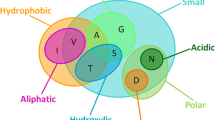Summary
All the codons of the genetic code can be arranged into the closed one-step mutation ring, containing three periods of the same sequence of mutations (2,3,3,3,1,3,3,3,1,3,3,3,1,3,3,3,2,3,3,3). The codons of Gly play a role of the connecting element between the end of the third, and the beginning of the first period of the genetic code. The reactivity of amino acids, expressed by the reaction rates of aminolysis reaction of N-hydroxysuccinimide esters of protected amino acids with p-anisidine, changes periodically with the respect to the mutation periods of the genetic code. Chou-Fasman P α as well as P β conformational parameters of amino acids, and also the compositional frequencies of amino acids in proteins, demonstrate the pseudosymmetry pattern with respect to the center of one-step mutation ring, which is situated between Thr ACY and ACR codons.
Similar content being viewed by others
References
Andreasen PH, Dreisig H, Kristiansen K (1987) Unusual ciliate — specific codons in Tetrahymena mRNAs are translated correctly in a rabbit reticulocyte lysate supplemented with a subcellular fraction from Tetrahymena. Biochem J 244: 331–335
Argyle E (1980) A similarity ring for amino acids based on their evolutionary substitution rates. Origins Life 10: 357–360
Chou PY, Fasman GD (1974) Conformational parameters for amino acids in helical,β-sheet, and random coil regions calculated from proteins. Biochemistry 13: 211–222
Chou PY, Fasman GD (1978) Prediction of secondary structure of proteins from their amino acid sequence. Adv Enzymol Relat Areas Mol Biol 47: 45–148
Dayhoff MO, Hunt LT, Hurst-Calderone S (1978) Atlas of protein sequence and structure, vol 5, Suppl 3In: Dayhoff MO (ed), National Biomedical Res Found, Washington DC, p 363
Di Giulio M (1989) Some aspects of the organization and evolution of the genetic code. J Mol Evol 29: 191–201
Fox TD (1987) Natural variation in the genetic code. Ann Rev Genet 21: 67–91
Hanyu N, Kuchino Y, Nishimura S, Beier H (1986) Dramatic events in ciliate evolution: alternation of UAA and UAG termination codons of glutamine codons due to anticodon mutations in two Tetrahymena tRNAGln. EMBO J 5: 1307–1311
Hasegawa M, Miyata T (1980) On the antisymmetry of the amino acid code table. Origins Life 10: 265–270
Jungck JR (1978) The genetic code as a periodic table. J Mol Evol 11: 211–224
Jukes T, Holmquist R, Moise H (1975) Amino acid composition of proteins: selection against the genetic code. Science 189: 50–51
Kim ChA, Berg JM (1993) Thermodynamicβ-sheet propensities measured using a Zinkfingers host peptide. Nature 362: 267–270
Lacey JC Jr, Mullins DW Jr (1983) Experimental studies related to the origin of the genetic code and the process of the protein synthesis — a review. Origins Life 13: 3–42
Pieber M, Tohá CJ (1983) Code dependent conservation of the physico-chemical properties in amino acid substitution. Origins Life 13: 139–146
Siemion IZ (1994a) The regularity of changes of the Chou-Fasman parameters within the genetic code. BioSystem 32: 25–35
Siemion IZ (1994b) Compositional frequencies of amino acids in the proteins and the genetic code. BioSystem (in press)
Siemion IZ, Stefanowicz P (1992a) Periodical changes of amino acid reactivity within the genetic code. BioSystems 27: 77–84
Siemion IZ, Stefanowicz P (1992b) The chemical periodicity within the genetic code. Bull Polish Acad Sci Chemistry 40: 11–20
Sjöström M, Wold S (1985) A multivariate study of the relationship between the genetic code and physical-chemical properties of amino acids. J Mol Evol 22: 272–277
Stefanowicz P, Siemion IZ (1992) Reactivity of N-hydroxysuccinimide esters. Polish J Chem 66: 111–116
Taylor FJR, Coates D (1989) The code within codons. BioSystems 22: 177–187
Topal MD, Fresco JR (1976) Complementary base pairing and the origin of substitution mutations. Nature 263: 285–289
Volkenstein MV (1966) The genetic coding of the protein structure. Biochim Biophys Acta 119: 421–424
Weber AL, Lacey JC Jr (1978) Genetic code correlations: amino acids and their anticodon nucleotides. J Mol Evol 11: 199–211
Woese CR, Dugre DH, Saxinger WC, Dugre SA (1966) The molecular basis of the genetic code. Proc Natl Acad Sci USA 55: 996–974
Author information
Authors and Affiliations
Rights and permissions
About this article
Cite this article
Siemion, I.Z. The regularities of the changes of amino acid physico-chemical properties within the genetic code. Amino Acids 8, 1–13 (1995). https://doi.org/10.1007/BF00806539
Received:
Accepted:
Issue Date:
DOI: https://doi.org/10.1007/BF00806539




